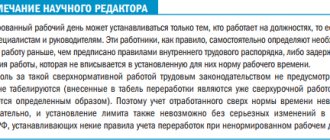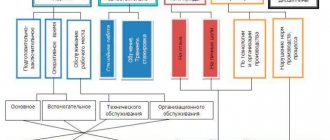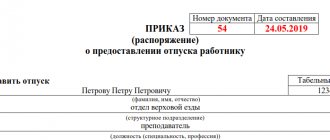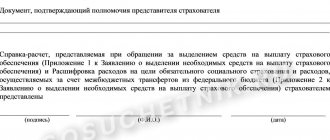This is the answer to the frequent question: irregular working hours - what is it? It is asked not only by employees, but also by employers. In the article, we not only examined what an irregular working day is under the Labor Code of the Russian Federation, but also told us how to establish it in an organization, for which employees there are restrictions, and what are the differences from regular overtime by order of the employer.
The main difference between this daily routine and overtime work is that the latter is limited in time: 120 hours per year according to the Labor Code of the Russian Federation, is paid at an increased rate, is involved in it only for production reasons, and this requires the written consent of the employee. And if a work schedule is established for him, which we discuss in the article, he can be involved in processing from case to case, and no consent of the employee is required.
Related documents
- Sample application for a pregnant woman to transfer to another job
- Sample application from an employee for transfer to another job in accordance with a medical report
- Notifying the employee about the start of vacation
- Fixed-term employment contract with a foreign worker
- Act on being late for work
- Acceptance certificate (for an employment agreement for one-time work)
- Act of special investigation of the accident (order of the State Education of the USSR dated 01.10.90 No. 639)
- Application form for employment
- Certificate of acceptance of works (services, products)
- Business trip order form (sample)
- Contract (employment agreement) - option
- Agreement between VTC members (employment agreement - option)
- Qualification characteristics of an accountant used in drawing up a contract for employment and remuneration
- Qualification characteristics of an accountant-auditor used when drawing up a contract for hiring and remuneration
- Qualification characteristics of a warehouse manager used when drawing up a contract for hiring and remuneration
- Qualification characteristics of the manager of the central warehouse used when drawing up a contract for hiring and remuneration
- Qualification characteristics of the collector used when drawing up a contract for hiring and remuneration
- Qualification characteristics of a cashier used in drawing up a contract for hiring and remuneration
- Qualification characteristics of an economist in accounting and analysis of economic activities, used in drawing up a contract for hiring and remuneration
- Qualification characteristics of a financial economist used in drawing up a contract for hiring and remuneration
- Qualification characteristics of a legal consultant used in drawing up a contract for hiring and remuneration
- Contract (employment agreement with special conditions)
- Contract with the chief accountant (option
Legal Requirements
- designation of the employer (name of the company, who represents it according to the charter or power of attorney);
- Full name of the employee;
- place and date of signing (if contracts are assigned numbers, then the number corresponding to the registration log);
- place of work (address of the company or its division);
- position (assigned in the staffing table);
- profession, qualification, rank (if the work is dangerous or harmful, the profession is written in strict accordance with the list of such works, otherwise the harmfulness will not be counted when applying for a pension);
- start date of work (if the contract is fixed-term, then the end date);
- salary amount (sum of salary, bonuses and allowances in numbers);
- working hours (here it is indicated that the employee is hired on NSD terms);
- compensation for harmful or dangerous work (dispensing milk, work clothes, etc.);
- working conditions (traveling, mobile, etc.);
- conditions of the workplace (what is equipped);
- condition on social insurance;
- probationary period (if necessary);
- condition on non-disclosure of trade secrets;
- company details (TIN, OGRN, address, bank account);
- employee details (address, passport details).
Nuances
As for disabled people, pregnant employees or mothers of babies under three years of age, the interpretation is clear: if there is a certificate from a doctor that additional work is contraindicated, then the employment contract cannot include a clause on non-working hours.
- Regulations on irregular working hours. The document sets out the conditions for registration, a list of positions, a list of compensation, as well as restrictions.
- Inner order rules. Provisions on irregular working hours can be enshrined in this document, both as an annex to it and in certain of its paragraphs.
- List of positions. This document identifies positions for which it is possible to establish an irregular working day. The list is approved by a collective labor agreement or other regulatory act of the organization, taking into account the opinion of the representative body of the company. If the organization does not have a body representing the interests of employees, the list is approved by the employer. In addition, the corresponding lists can be legislated in industry documents.
Reflection of conditions
There is a general practical procedure within which such documentation is prepared.
- First, you become familiar with the acts related to the irregular schedule. The main thing is not to forget about vacation and basic compensation conditions. The employee reads the document during the employment process or during the introduction of certain changes to it.
- If certain changes are simply made, an additional agreement is drawn up. It stipulates the conditions for the new schedule.
- After this, an order is issued stating that the procedure is completed.
- Making adjustments to your personal file is also an important step in this entire event.
- If necessary, management makes notes in personal files. This is necessary if there is a transfer from one position to another. If NSD is intended only for the second position, then the work book indicates on what grounds and considerations this transfer was made.
From the required set of documents, an order document establishing this regime is drawn up. Its creation occurs only after written consent is provided by the employee.
Additional agreement
A number of documents that are necessary for the correct registration of persons working under irregular hours include an additional agreement to the employment contract. It can clearly display all the necessary nuances of certain working conditions.
Also, this document indicates agreements regarding an irregular day between the employee and the manager, has legal force and contains the following mandatory points in accordance with the existing sample:
- Title of the document.
In capital letters you need to write down the name of the document - “Additional agreement on irregular working hours”, then in small letters write down the date from which the document comes into force and the number of the agreement.
In the main part you need to display the personal data and positions of the employee and manager between whom the agreement is concluded.
Mention the provisions taken as the basis for drawing up a document of an additional nature, and then move on to the main points.
In these clauses, for example, you can stipulate vacation time or other working conditions.
- Decide and write down the number of days allotted for vacation, and the number and date of the order that approved this condition.
- Be sure to indicate which part of the employment contract the main clause of the additional agreement relates to.
- There must be a part fixing the date from which the information in the employment contract can be changed at the request of one or both parties.
- The end of the additional agreement is considered correctly executed if it contains information about the passport details, locations and postal addresses of both the employer and the employee.
- This information must be followed by a signature, surname and initials, as well as the date.
Download a sample additional agreement with irregular working hours here for free.
Expert opinion
Kuzmin Ivan Timofeevich
Legal consultant with 6 years of experience. Specializes in the field of civil law. Member of the Bar Association.
Since the agreement is concluded in two copies, one copy must be provided to the employee. As a final step, he is obliged, after the line titled “A copy of the additional agreement has been received,” to re-sign and date it.
General concepts
An irregular working day in an employment contract is a schedule that allows individuals to work beyond the norm established in the Labor Code of the Russian Federation. This need is justified by production needs, when it is necessary to perform a larger amount of work.
Irregular work includes any activity that does not have a clearly defined time frame. The subtleties of drawing up an employment agreement are determined by Article No. 57 of the Labor Code of the Russian Federation.
An agreement that violates the provisions of this article is automatically considered illegitimate. In this case, there is no need to introduce irregular working hours, since the employment contract (a sample is presented below) simply will not have legal force.
Article number 101 of the Labor Code of the Russian Federation gives the manager the right to provide employees with a certain amount of work that exceeds the existing generally accepted norm. These works must be performed during hours that are not specified in the employment contract.
It is also worth noting that the legislation of the Russian Federation took care of individuals working overtime, providing them with the opportunity for additional rest.
In this case, the employee is entitled to leave not at his own expense, but paid by the employer. You can read about this in Article 119 of the Labor Code. If you have additional questions, please review articles numbered 97, 116 and 126.
An irregular working day is a specific schedule according to which individuals periodically work extra time (in excess of the established standard working hours) in order to cope with the required amount of work on time.
The main characteristics of an irregular working day include the following:
- Such a schedule can be established only for a certain category of individuals holding certain job positions.
- A slightly longer working day than existing standards should be introduced only when there is an urgent need for it.
- This mode is usually used for individuals engaged in such types of work, the performance of which cannot be accurately recorded using time.
- An irregular schedule is best suited for those employees who have expressed a desire to independently manage their working time.
- Any types of work that require seasonal performance, as well as the relevance of which depends on the time of day, and work that does not have clearly established time boundaries, are considered irregular.
We recommend that you pay attention to Article 57 of the Labor Code of the Russian Federation, which displays the main points and rules that require mandatory compliance when concluding an employment contract.
We invite you to read: What does every businessman need to know about the contract?
If a document is drawn up without taking into account the requirements of Article 57, then it will automatically not have legal force. And in an agreement that has no legal value, it makes no sense to stipulate any conditions, including those regarding irregular working hours.
You can find a sample employment contract with irregular working hours here.
The Labor Code specifies clear boundaries of working hours during which employees must perform their work duties. Namely, this is 40 working hours per week, which with a 5-day working week gives 8 working hours per day.
In order for an employee to work outside of this time, you can involve him in overtime work or introduce irregular working hours. It is not profitable for an employer to involve an employee in overtime work, since he will have to pay for overtime, and there is a limit on the total number of hours.
But with a normal working day, there are no restrictions, and they are compensated in the form of additional vacation days.
- What is an irregular working day?
- With whom can you enter into an employment contract with irregular working hours?
- With whom you cannot enter into an employment contract with irregular working hours
- Features of an employment contract with irregular working hours
- Sample of filling out an employment contract with irregular working hours
Part-time job
There is no law prohibiting part-time workers from using irregular working hours. However, in practice, its establishment is possible only when the part-time worker is free from performing work functions on some days, since in another case a part-time working day has been introduced for him.
The latest changes regarding irregular working hours were made to Art. 101 of the Labor Code of the Russian Federation in 2021. Then the legislator introduced a new rule according to which employees working on a part-time basis can establish an irregular working day only if the following conditions are met:
- a part-time working week is established by agreement of the parties;
- this part-time work week is established with a full-time work day.
Thus, at the moment, an irregular working day, according to Art. 101 of the Labor Code of the Russian Federation in the latest edition cannot be established for part-time workers, unless it is a part-time working week.
What is an irregular working day?
The term “irregular day” of the Labor Code of the Russian Federation means such a work regime when an employee can sometimes be involved in work at a time that goes beyond the established standards, that is, after the end of the day or shift according to the schedule or before they begin.
Organization managers are more interested in formalizing irregular work hours than in paying overtime.
The table describes the conditions for registering irregular working hours and overtime work:
| Differences | Irregular working hours | Overtime work |
| Terms and period of work with specified restrictions | Not all the time, no restrictions | For a year no more than 120 hours and 4 hours for 2 days in a row. |
| Payment of compensation | Additional days for vacation | In the form of monetary remuneration or compensated by time off |
| Employee consent | No need | Necessary |
| Specifying the terms and conditions in the contract | Necessarily | Not necessary |
Expert opinion
Gusev Pavel Petrovich
Lawyer with 8 years of experience. Specialization: family law. Has experience in defense in court.
If the contract does not contain information about this, you should know: this is a gross violation. The code clearly states the need to mark this information in all relevant official documents.
Worker's compensation
When concluding an employment contract, which provides for the possibility of working beyond the standard length of the day, the employer can determine in this document additional compensation to the employee for the corresponding working conditions. However, the law does not provide for any obligation to pay workers any additional payments.
But the employment contract must provide for additional leave, and its duration, according to Art. 119 of the Labor Code of the Russian Federation, there must be at least 3 calendar days added to the regular leave provided for this category of workers. In relation to persons employed in the civil service in government bodies, this norm is further confirmed by paragraph 6 of Art. 46 of the law of July 27, 2004 No. 79-FZ.
The following points must be taken into account:
- An employee has the right to additional vacation days even if during the year he was not actually involved in work outside the normatively established time.
- Time worked beyond the standard duration must be taken into account by the employer (this is required by Article 91 of the Labor Code of the Russian Federation). Since the rule about entering such time into the accounting sheet does not apply to irregular working hours, it is recorded in another way, for example, by compiling a separate journal.
With whom can you enter into an employment contract with irregular working hours?
The legislation of the Russian Federation does not establish an exact list of positions with irregular working hours, but contains recommendations on this matter. The manager has the right to independently approve the list of specialists who will be required to periodically work beyond the norm.
Decree of the Government of the Russian Federation No. 884 of December 11, 2002 establishes an approximate list of positions with an irregular schedule, which includes:
- housekeeping staff;
- managers (for example, the CEO of a company);
- maintenance workers;
- representatives of creative professions (for example, writers, artists);
- other employees whose working time cannot be properly recorded.
Thus, management has the right to independently establish a list of positions with an irregular schedule, but it must be recorded on paper in writing.
To whom and how is an irregular schedule established?
It is not people of a specific profession who are recruited to work extra time, but specialists who work in a specific position. There are no restrictions in the selection of positions for which NSD is applied. At the same time, the specifics of the work are taken into account. The list is formed in a separate order.
It is unacceptable to establish NSD for all positions available in the organization. This approach will be called into question at the first inspection by regulatory authorities.
There is only one exception - for drivers. The working regime, provision of rest and other conditions for this category of employees are authorized to be approved by the Ministry of Transport of Russia (Part 2 of Article 329 of the Labor Code).
The NSD is established only for some drivers (clause 14 of the Order of the Ministry of Transport of Russia dated August 20, 2004 N 15) for:
- drivers of passenger cars (except taxis);
- involved in expeditions and survey parties.
Documentation of conditions
Everyone should know their working conditions. Therefore, already at the employment stage, future employees are familiarized with the collective agreement, PVTR and other internal documentation relating to the position and functions performed.
The NSD regime is correctly recorded in the documents. For this purpose, a list of positions to which it will be applied is approved.
The conditions under which NSD is used, as well as the procedure for its compensation, are specified in the clauses of the employment agreement (Article 57 of the Labor Code). If this is not done, you cannot be legally hired for additional labor. The signature indicates the person’s consent to the application of the agreed regime against him, if such a need arises.
Separate wording on the definition of an additional regime is provided in the order by which the employee is admitted to the organization.
The transfer of a specialist to NSD who previously worked on a regular schedule must be accompanied by a written warning. The message is sent two months before the planned work (Part 2 of Article 74 of the Labor Code).
It is up to the employee to agree or not, because the new conditions may be unacceptable to him. Then he should be offered other vacancies (even with a lower salary) or another position. An offer to work in another location is acceptable if this condition is specified in internal documentation.
If the offer is not satisfactory or there are no vacancies, the contract is subject to termination in accordance with clause 7 of part 1 of Article 77 of the Labor Code.
If you agree to work extra time, an agreement to the contract is drawn up. Then an order is generated reflecting the fact that the employee has changed his previous work regime.
Development and approval of a list of positions with NSD
A list of positions for workers with irregular working hours is established with the following documentation (Article 101 of the Labor Code):
- collective agreement (or annex to it);
- a separate agreement;
- local regulations (for example, PVTR, regulations on recording labor time).
First of all, the use of NSD needs to be consolidated in the PVTR. These actions are mandatory in accordance with Article 189 of the Labor Code.
The list is approved by issuing a separate order on behalf of management. When making a decision, the opinion of representatives of the trade union (if any) is taken into account.
In accordance with the Russian Federation GD dated December 11, 2002 N 884, an NSD may be appointed (clause 2):
- management, technical or business personnel;
- specialists whose work hours cannot be accurately recorded;
- employees who allocate their own time to work;
- if the specifics of the activity divides working time into several parts of indefinite duration.
Designation in the employment contract
The primary document that indicates the irregularity of the schedule is the agreement with the employee (Articles 57, 101 of the Labor Code). The terms of the NSD are essential and therefore are always provided for in the contract.
Before signing the contract, the specialist needs to familiarize himself with the list of positions to which NSD applies. He should see that his position is also on this list.
In addition, a clause should be provided that defines the procedure and amount of compensation for work during additional time, unless a separate provision has been developed and approved.
If a specialist is transferred to a position with NSD, then an additional agreement is prepared for the existing contract. As an option, a new agreement with an updated version is signed (Articles 72, 72.1 of the Labor Code). Thus, the employee is provided with guarantees of compliance with his labor rights.
Nenorm_rab_den
Drawing up an order establishing irregular working hours
An order on irregular working hours will be required if NSD is assigned to an already working specialist, and such a regime has not previously been prescribed in the contract.
There is no unified form, so the template is usually developed by the organization with its further approval.
- “Order” is written in the central part. Then at the bottom they put the document number (registered in the accounting journal) and the date. The preamble indicates the reasons for the application of the regime.
- The order is issued only when a specialist position is included in the list of positions with NSD. It is personalized, as it determines the regime for a specific employee. Therefore, the order specifies the full name of the specialist, his position, the name of the unit and the place where he works. It is important to indicate the day from which work in the new mode will begin.
- The next point includes instructing responsible persons to prepare and implement the NSD (for example, issue notifications and send them to employees).
- The final paragraph reflects information about the person responsible for fulfilling the terms of the order.
The manager signs the document with a transcript and affixes the organization’s seal, after which he submits it for execution. The order is provided to the employee for review.
obrazec-prikaz-o-nenormirovannom-rabochem-dne
With whom you cannot enter into an employment contract with irregular working hours
When signing an employment contract, the employer must know that for certain groups of employees, extended working hours are strictly prohibited (Article 92, Article 94 of the Labor Code of the Russian Federation), this applies to:
- pregnant women (Article 259 of the Labor Code);
- employees for the duration of training (Article 203 of the Labor Code);
- minor employees of the company (Article 99 of the Labor Code);
- persons with a disability category;
- women who have children under 3 years of age;
- fathers who raise children without a mother;
- persons who are guardians of minors (it is possible to be involved in non-standard work hours, with mandatory medical permission), as specified in Art. 99 TK.
Special cases
Does the law protect pregnant women from long hours? Unfortunately no. In this case, the Labor Code prohibits only overtime work. A pregnant woman has the right, for medical reasons, to ask her employer to transfer her to another position with a suitable schedule. The law sets a restriction for single mothers - their working hours must be reduced if the child is under 14 years old. However, there is no direct ban on the use of irregular work.
In any case, the employer does not have the right to exceed his authority and regularly involve employees in additional work. If their rights are violated, they can terminate the contract or appeal to the labor inspectorate, as well as to court.
Features of an employment contract with irregular working hours
The involvement of an employee in an irregular work schedule must be stipulated in the contract or in an appendix to it. If the employment contract stipulates other conditions, then changing them or using an employee contrary to these conditions is illegal.
The procedure for attracting employees to this type of work must be stipulated in the regulations of the organization. The employee must be warned about this.
The presence of a note about an irregular schedule in an employment contract implies that the manager is not obliged to constantly notify the employee in writing. To do this, a verbal request is sufficient, since the employee has already signed the contract and thus agreed to such working conditions.
In this case, the employee will not receive compensation for overtime. He will be given additional days of vacation.
If an employee is called on a day off, he must be paid double the average wage. You just need to notify about this in advance. If an employee is called to work at night, payment is made at the standard rate, unless the manager calls the employee on a special order.
Important. All overtime hours worked must be recorded in the log book.
For questions about payment
As already mentioned, in the usual sense of the word it is absent. We can only talk about this if time-based payment is used, or the amount depends on production and compliance with its standards. For example, such schemes are often used for accountants. The main thing is that overtime work of this type does not become systemic.
When an enterprise operates around the clock, a summary accounting scheme is acceptable, or when other features do not allow separate changes to be made for specific departments. The summary accounting method can also be applied to those who use an irregular schedule.
Here are some recommendations:
- The accounting period consists not only of days, but also of regular weekends with holidays and rest.
- The company's collective agreement is the basis for all operations.
- It is necessary to determine either the daily duration of work or the total by week. Shifts vary during these periods. The main thing is that the final calculation results comply with regulatory requirements.
If management increases their working hours, including overtime, they must change the duration of their days off. They are provided on a rotating basis.
Total accounting requires a separate definition of the standard. Why is the number of days of work multiplied by seven? Seven is the norm for weeks consisting of six days. It is impossible to do without taking into account the time when the reductions were introduced.
Sample of filling out an employment contract with irregular working hours
When drawing up an employment contract with irregular working hours, a standard form of an employment contract is used. It specifies all standard conditions and, if necessary, includes additional clauses.
A standard template for an agreement on an irregular day is drawn up according to the following scheme:
A working day with an irregular schedule can be one of the parts of an employment contract. This means that the working hours for employees increase. Issues related to the execution of contracts and their terms are of interest not only to managers, but also to the employees themselves.
Position
Today, there is a certain sample designed to legally consolidate the provisions on such a work schedule. This document, according to the current model, consists of the following parts:
- “Header” of the document.
In the upper left corner it is necessary to write down the full name of the organization or enterprise where irregular working hours are used, as well as indicate the type of these provisions (about irregular working hours). And on the right side write who approved these provisions (initials, surname and position) and the date of preparation.
It is also necessary to mention on the basis of which documents the decision was made to implement these provisions.
The first part displays general provisions.
This part describes the essence of an irregular schedule and provides the legislative framework on the basis of which it is introduced by the management of the enterprise.
Second part, list of employees.
Here we are talking about which category of individuals such conditions can apply to.
This category includes persons working as heads of any commercial organization, as well as their deputies, persons holding management positions within a specific department and their assistants, persons performing work to staff the organization with the required professions, and lawyers.
The second part of the provision reflects the fact that individuals can be recruited by the manager for the purpose of performing additional work only if this is stated in the employment contract. In addition, it must be stated how hours worked are recorded.
Employees have every right not to work overtime if the employer requires it on weekends. On those days that are not among the working days fixed in the schedule of the employment contract, the employee is also not obliged to work.
However, there are a number of certain exceptions, which are contained in Articles 113 and 153 of the Labor Code.
The third part is about compensation.
Contains information about compensation provided to employees, namely additional leave, which the employer pays at intervals of one year. It also contains information on what factors (type of work activity and amount of work performed) are used to determine the duration of the vacation.
The final part of the document.
Below it is necessary to list those persons with the help of whom this provision was agreed upon. Usually this is the deputy director, head of the human resources department and accountant.
You can find a sample of the Regulations on Irregular Working Days here.
Which categories are eligible and which are not?
The manager is required to draw up a separate document listing the employees for whom an irregular day is introduced.
The main thing is for the manager to become familiar with possible prohibitions and restrictions in advance.
The restrictions in this case include:
- persons guarding minors
- fathers who raise children without a mother
- women with children under three years of age
- those who received a disability group
- employees who have not reached the age of majority
- employees also undergoing training
- pregnant women
The absence of a list of positions to which the rules apply makes it impossible to introduce working days beyond the accepted limits.
Reference
In some cases, individuals may need to present a certificate indicating that they work on an overtime work schedule. This certificate can be issued by the manager, who needs to be informed of the place requiring this document, so that he can record it in its upper part.
Then, in the center, in large letters, the type of document is written - HELP. The text must indicate the data of the individual, the position he holds and the articles based on which an irregular regime was established for him.
Also make sure that the manager does not forget to indicate that the employee belongs to the category of persons who, according to current legislation, can work outside the norm. He also displayed a fact indicating that he does not involve the employee in work on days intended for weekends.
At the bottom is the date, signature of the boss and seal of the company.
You can find a form for a certificate of irregular working hours here.
Rules for drawing up a contract
Working days and hours outside the norm are terms that must be included in employment contracts. Article 57 of the Labor Law describes in detail issues related to this phenomenon. It is necessary to register shifts and hours that go beyond the generally accepted framework.
Drawing up agreements requires the use of almost standard forms. Only one point is added regarding the irregular schedule. An additional agreement is concluded if someone who has already been working in the company for a certain period of time is transferred to an irregular schedule.
Another important aspect in this case is the registration of hours worked and vacation pay. The duration of the latter is determined in internal documentation. The minimum required quantity is three days. There are no restrictions on maximum periods of rest.
There is a general procedure in which such documents are drawn up:
- First, a company employee must be familiarized with the acts related to irregular work schedules. The main thing is not to forget about vacation pay and compensation conditions. The employee gets acquainted with the document when he is hired for a position, or at the time of changes.
- When simple changes are made, an additional agreement is drawn up, and in it they write about the conditions of the new schedule.
- After this, an order is issued to complete the procedure.
- Corresponding adjustments are made to your personal file.
- If necessary, management puts marks in personal files. For example, this is necessary when transferring from one position to another. When only the second position has an irregular schedule, they write in the work book about why the transfer was made.
From the necessary papers, an order is drawn up to establish this operating mode, as well as a notification to the employee regarding changes in the schedule. The order is issued only after the employee has given his written consent.
What other regulatory features are there?
In any case, employment contracts become tools with universal and effective action. The main thing to remember is that this is a two-sided document.
It is designed to provide stability and protection to the employee, and not only provide protection and regulation of rights and responsibilities for managers. A contract can be one of the most effective means for those who introduce irregular schedules.
Expert opinion
Kuzmin Ivan Timofeevich
Legal consultant with 6 years of experience. Specializes in the field of civil law. Member of the Bar Association.
A work contract is a type of compensation agreement, because the performance of work by one party corresponds to the monetary reward of the second. This is a bilateral mutual agreement, therefore each participant has rights with responsibilities.
There are several significant differences that we recommend taking a closer look at:
- Employment contracts as a subject describe the very implementation of the activity. In a contract, the specific end result is important. It is unacceptable to execute a contract with the participation of an individual if it is planned that he will perform the function of an accountant. In this case, the employee does not produce the final result, he simply performs a series of duties.
- When contracting, the contractor performs the work using his own materials and what was purchased with his own funds. But we can also agree that the customer will be responsible for this. But in employment contracts there is no liability for the loss of work results. It is only important to follow the internal regulations and provide employees with everything they need.
- The contract can be concluded both between individuals and between legal entities.
The general rule is that any changes to an irregular schedule are made only if the employee has agreed in writing to certain actions. If an employee disagrees, he has the right to continue to perform his duties according to the old schedule.
With the exception of situations where changes are related to organizational or technical working conditions.
Then the manager himself becomes the initiator of adjustments. If he complies with all the rules specified in Article 74 of the Labor Code of the Russian Federation, a warning to employees in writing is required, no later than sixty days before the changes are introduced.
Cancellation of working days outside the generally accepted framework should not lead to deprivation of the right to take vacations. If the appropriate schedule was established before the documents were changed, it is advisable to preserve the right to rest for those who have not yet taken advantage of it before the adjustments appear. At least throughout the current year.
What compensation is provided in this case?
Typically, overtime with this regime is not paid, but legislators do not allow employees to be left without compensation at all.
Annual rest time paid for by management is a right for those who work above the norm, as Article 119 of the Labor Code of the Russian Federation says. The duration is written in the company's internal regulations, or in agreements with employees, collective and individual.
Such vacations must be at least three days. Vacation can be taken separately, or added to the time of the main paid vacation.
At the same time, paid leave becomes a standard right, regardless of whether the employee leaves on time or overworks.
Some employees ask for additional paid time off if they feel they have too much work to do. But the only possible compensation is additional rest time.
Order of the Ministry of Internal Affairs on additional leave
Persons working in the Ministry of Internal Affairs in irregular hours are awarded the right to receive additional vacation days. This was recorded using the order of the Ministry of Internal Affairs numbered 849 , which entered into force on December 6, 2012.
The sample order contains a number of the following basic instructions:
It should be noted that a list of specific positions is attached to the sample of this order.
At the same time, individuals performing the duties of these employees for some time are assigned an irregular work schedule. And workers automatically fall into the category of people who have the opportunity to receive additional rest.
About time tracking
A very pressing issue remains related to the need to confirm and justify the inclusion in the base of income tax expenses tied to compensation payments for production in excess of standards.
The rules are standard, but several features should be noted:
- A working day in excess of standards can be introduced for a few reasons, one of them is the need to use new technologies in management and production. This need appears sporadically, there is no connection with frequency.
- It is necessary to have a criterion for generating a list of works that require an irregular schedule.
- To monitor the implementation of the regime, a specialist report is drawn up, where the effectiveness of the work done is discussed.
How many overtime hours are allowed?
Unlike overtime work, which has permissible time limits, the maximum number of overtime hours is not regulated by law. The employer has the right to involve an employee not on a regular basis, but occasionally, in performing duties for more than 40 hours a week, but how long such episodes can last is not determined. This criterion can be included in the order, but it remains at the discretion of the employer.
How are irregular days counted?
The working time sheet does not contain a separate column for entering overtime hours. This is not required by either personnel officers or accountants, since payment for additional hours is not provided. The timesheet indicates only the standard working time, and additional leave is applied regardless of the days actually worked.











